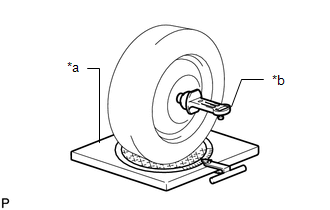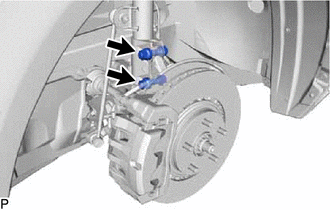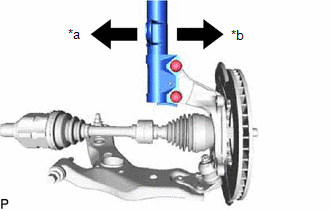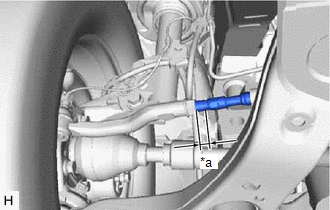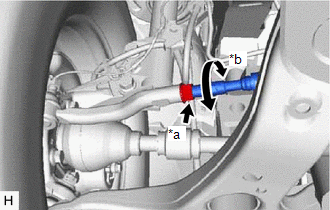Lexus NX: Adjustment
ADJUSTMENT
CAUTION / NOTICE / HINT
NOTICE:
If a wheel alignment has been performed, or if suspension or underbody components have been removed/installed or replaced, be sure to perform the following initialization procedure in order for the system to function normally:
- Perform zero point calibration of the yaw rate and acceleration sensor.
PROCEDURE
1. INSPECT TIRES
Click here 
2. MEASURE VEHICLE HEIGHT
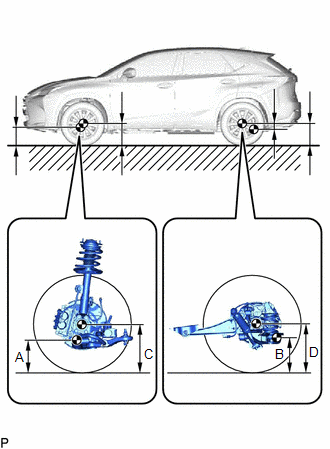
NOTICE:
- Before inspecting the wheel alignment, adjust the vehicle height to the specified value.
- Be sure to perform the measurement on a level surface.
- If it is necessary to go under the vehicle for measurement, make sure that the parking brake is applied and the vehicle is secured with chocks.
(a) Bounce the vehicle up and down at the corners several times to stabilize the suspension.
(b) Measure the vehicle height.
Measuring points:
A
Ground clearance of center of front lower No. 1 suspension arm bushing set bolt
B
Ground clearance of center of rear No. 2 suspension arm bushing set bolt
C
Ground clearance of center of front wheel
D
Ground clearance of center of rear wheel
NOTICE:
The standard value shown here is a value that is used for adjusting the wheel alignment and does not indicate the height of an actual vehicle.
Standard Vehicle Height (Unloaded Vehicle):
| Tire Size | Front C - A | Rear D - B |
|---|---|---|
| 225/65R17 | 111 mm (4.37 in.) | 73 mm (2.87 in.) |
| 225/60R18 | 116 mm (4.57 in.) | 78 mm (3.07 in.) |
3. INSPECT CAMBER, CASTER AND STEERING AXIS INCLINATION
| (a) Install a camber-caster-kingpin gauge or place the front wheels on the center of a wheel alignment tester. |
|
(b) Inspect the camber, caster and steering axis inclination.
Standard Camber Inclination (Unloaded Vehicle):
| Camber Inclination | Right-left Difference |
|---|---|
| -0°15' +/-45' (-0.25° +/-0.75°) | 30' (0.50°) or less |
Standard Caster Inclination (Unloaded Vehicle):
| Tire Size | Caster Inclination | Right-left Difference |
|---|---|---|
| 225/65R17 | 6°00' +/-45' (6.00° +/-0.75°) | 30' (0.50°) or less |
| 225/60R18 | 6°05' +/-45' (6.08° +/-0.75°) | 30' (0.50°) or less |
Standard Steering Axis Inclination (Unloaded Vehicle):
| Tire Size | Steering Axis Inclination |
|---|---|
| 225/65R17 | 11°30' (11.50°) |
| 225/60R18 | 11°35' (11.58°) |
4. ADJUST CAMBER
NOTICE:
Inspect toe-in after the camber has been adjusted.
(a) Remove the front wheel.
Click here 
| (b) Remove the 2 nuts on the lower side of the front shock absorber. NOTICE: Keep the bolts inserted. |
|
(c) Remove the top and bottom bolts one at a time and confirm that the steering knuckle can move freely in the front shock absorber.
NOTICE:
Do not apply lubricants to the steering knuckle and shock absorber contact surfaces.
HINT:
- Reinstall each bolt after removing it and confirming steering knuckle movement.
- If the steering knuckle does not move freely in the front shock absorber, clean the installation surfaces of the front shock absorber and the steering knuckle.
(d) Temporarily install the 2 nuts (Step A).
| (e) Fully push or pull the front axle hub in the direction of the required adjustment (Step B). |
|
| (f) Tighten the nuts. Torque: 240 N·m {2447 kgf·cm, 177 ft·lbf} NOTICE: Prevent the bolts from rotating when tightening the nuts. |
|
(g) Install the front wheel.
Click here 
(h) Check the camber.
Standard Camber Inclination (Unloaded Vehicle):
| Camber Inclination | Right-left Difference |
|---|---|
| -0°15' +/-45' (-0.25° +/-0.75°) | 30' (0.50°) or less |
HINT:
Perform adjustments so that the value is as close as possible to the median of the specified range.
(i) Check the camber.
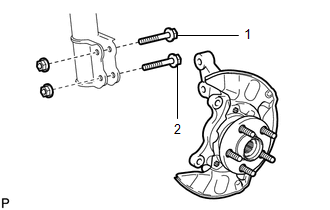
If the measured value is not within the specification, calculate the required adjustment amount using the formula below.
Camber adjustment amount = center value of the specified range - measured value.
Check the combination of installed bolts. Select appropriate bolts from the table below to adjust the camber to the specified values.
HINT:
Try to adjust the camber to the center of the specified range.
| Move Axle toward (+) in Step (B) | Move Axle toward (-) in Step (B) |
|---|---|
| Refer to table (1) (When moving the axle toward the positive side) | Refer to table (2) (When moving the axle toward the negative side) |
NOTICE:
Replace the nut with a new one when replacing a bolt.
(1) Table (1) (To move the axle hub toward the positive side)
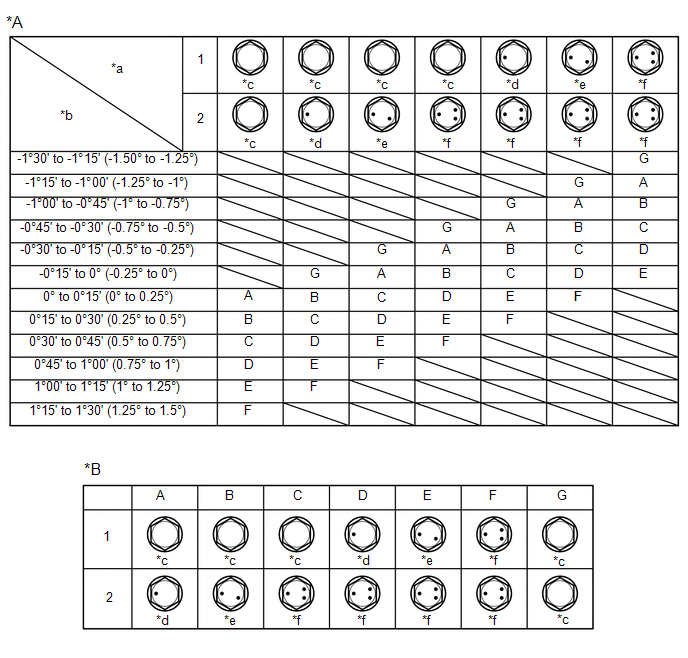
| *A | Table (1) (To move the axle hub toward the positive side) | *B | Selected Bolt Combination |
| *a | Installed Bolt | *b | Adjusting Value |
| *c | Standard Bolt | *d | 90105-17009 |
| *e | 90105-17010 | *f | 90105-17011 |
(2) Table (2) (To move the axle hub toward the negative side)
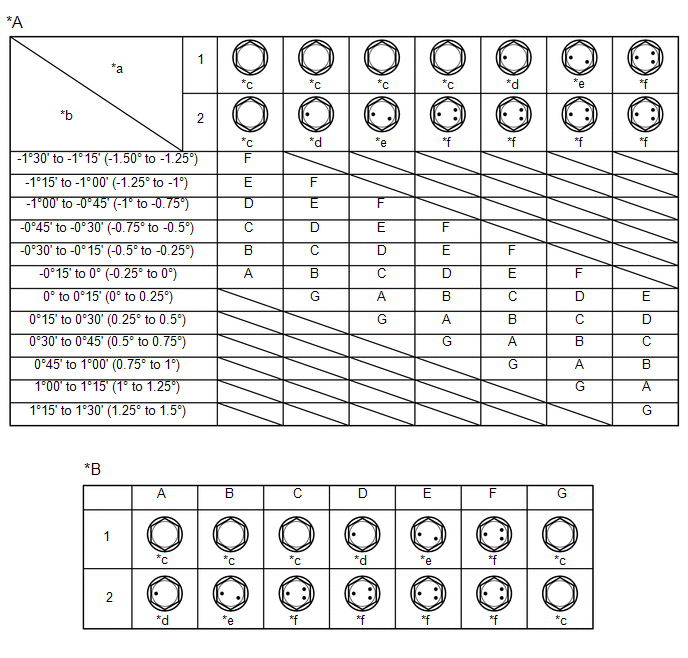
| *A | Table (2) (To move the axle hub toward the negative side) | *B | Selected Bolt Combination |
| *a | Installed Bolt | *b | Adjusting Value |
| *c | Standard Bolt | *d | 90105-17009 |
| *e | 90105-17010 | *f | 90105-17011 |
(j) If the camber was out of adjustment in the previous step, perform the adjust camber steps mentioned above. In step A, replace the existing bolts with the selected bolts.
HINT:
Replace one bolt at a time when replacing both bolts.
5. INSPECT TOE-IN
(a) Bounce the vehicle up and down at the corners to stabilize the suspension and inspect toe-in.
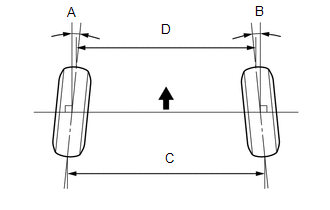
 | Front of the Vehicle |
Toe-in (Unloaded Vehicle):
| A + B C - D |
|---|
| A + B: 0°10' +/-10' (0.16°+/-0.16°) C - D: 2.0 +/-2.0 mm (0.08 +/-0.08 in.) |
HINT:
If the toe-in is not within the specified range, adjust it at the rack ends.
6. ADJUST TOE-IN
| (a) Make sure that the lengths of the right and left rack ends are almost the same. Standard difference: 1.5 mm (0.06 in.) or less |
|
(b) Remove the boot clips.
| (c) Loosen the tie rod end lock nuts. |
|
(d) Turn the right and left rack ends by an equal amount to adjust the toe-in to the center value.
Toe-in (Unloaded Vehicle):
| A + B C - D |
|---|
| A + B: 0°10' +/-10' (0.16°+/-0.16°) C - D: 2.0 +/-2.0 mm (0.08 +/-0.08 in.) |
HINT:
Perform adjustments so that the value is as close as possible to the median of the specified range.
(e) Tighten the tie rod end lock nuts.
Torque:
88 N·m {897 kgf·cm, 65 ft·lbf}
(f) Place the boots on the seats and install the clips.
NOTICE:
Make sure that the claws of the clip are facing in the direction that the vehicle travels.
HINT:
Make sure that the boots are not twisted.
7. INSPECT WHEEL ANGLE
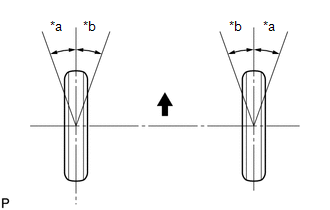
| *a | Inside |
| *b | Outside |
 | Front of the Vehicle |
(a) Turn the steering wheel to the left and right full lock positions and measure the turning angle.
Standard Wheel Turning Angle (Unloaded Vehicle):
| Tire Size | Inside Wheel | Outside Wheel (Reference) |
|---|---|---|
| 225/65R17 | 35°37' +/-2° (35.62° +/-2°) | 30°14' (30.23°) |
| 225/60R18 | 35°37' +/-2° (35.62° +/-2°) | 30°14' (30.23°) |
- If the angles are not as specified, check and adjust the right and left rack end lengths.
8. PLACE FRONT WHEELS FACING STRAIGHT AHEAD
9. PERFORM YAW RATE AND ACCELERATION SENSOR CALIBRATION
Click here 
10. ADJUST FORWARD RECOGNITION CAMERA (w/ LANE TRACING ASSIST SYSTEM)
-
One time recognition:
Click here

-
Sequential recognition:
Click here


